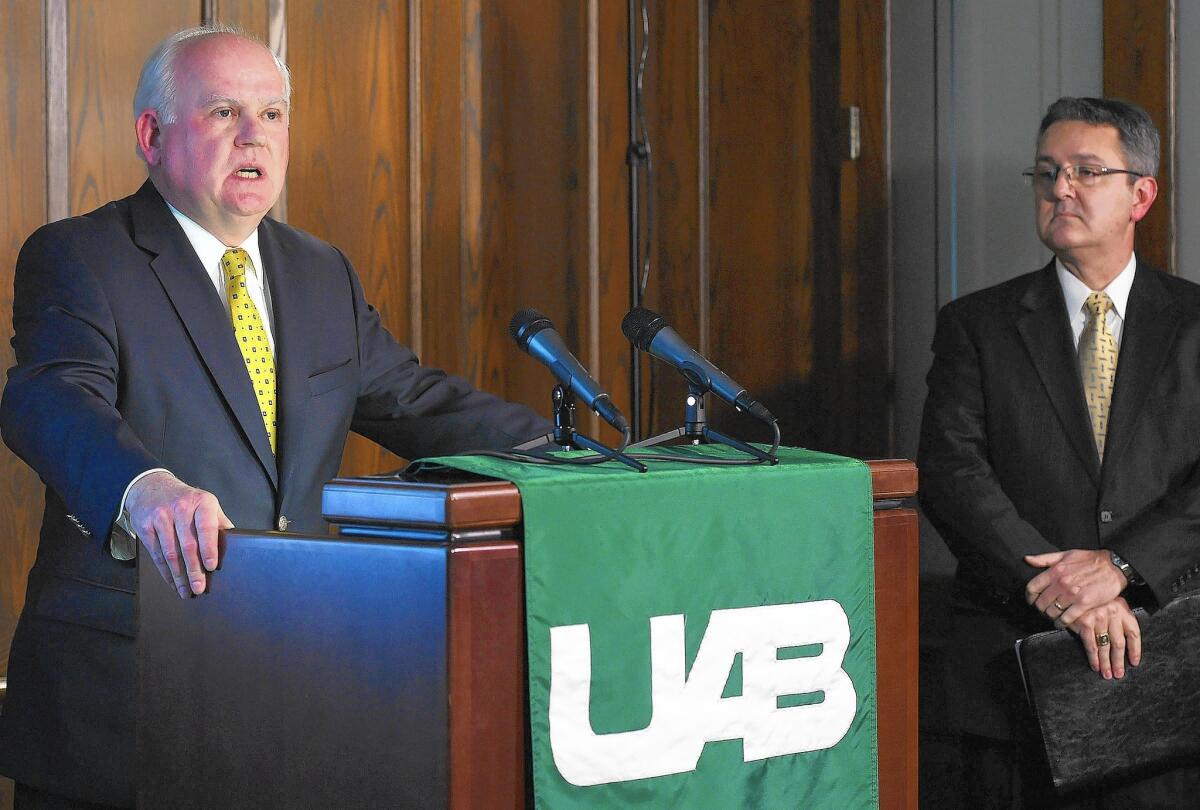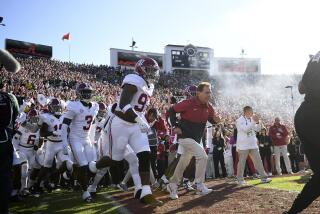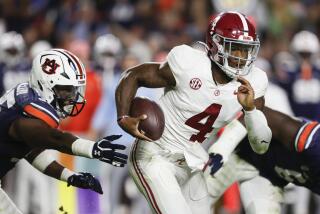University in Alabama ends football program, angering just about everyone

In the powerhouse world of Alabama college football, the Blazers have long been the scrappy underdog.
This season, there was a turnaround for the University of Alabama at Birmingham: A new coach led the team to six wins, game attendance doubled to more than 20,000, and after a 45-24 victory against Southern Miss, the Blazers became eligible to play in a bowl game for the first time in a decade.
Then it came crashing down.
A few days after that lopsided victory, university President Ray L. Watts announced he was killing the football program, making UAB the first college to drop a Division I football team in nearly 20 years. Five days later, no bowl invitation, either.
------------
FOR THE RECORD:
Alabama football: In the Dec. 31 Section A, an article about the reaction to the University of Alabama at Birmingham’s decision to end its football program said that the school’s president met with players and coaches at Legion Field, the off-campus stadium. He met with them at the school’s football office on campus. —
------------
“We finally win and our reward is, ‘We’re pulling your team?’” said Ty Long, 21, who kicked a field goal in what turned out to be the Blazers’ final game. “How is that possible in the state of Alabama, where football is the biggest thing?”
Watts said the decision was strictly financial: After spending $20 million each year subsidizing an unsuccessful team, it was time for UAB to cut its losses and put academics before athletics.
The university also cited a projected $22 million needed for football facilities, including a field house, indoor practice facility and a turf field.
“Football is simply not sustainable,” Watts said.
These are fighting words in Alabama. After announcing his decision Dec. 2, Watts needed police officers to escort him through a crowd of angry fans outside the football office, where he met with Blazer players and coaches.
The backlash has only intensified in recent weeks as Birmingham business leaders disputed Watts’ assertion that no one in the community had stepped up to donate money to the team.
“This is not about money,” said James Filler, a donor and co-founder of the newly formed UAB Football Foundation, who said he rallied a handful of businessmen to pledge $5 million to the football program last month.
“Boosters are sitting at the table with checks in hand,” said Michael Ketchum, a local banker and former UAB player. “Why will Watts not sit down with everyone in the community?”
In Birmingham — where more people watch ESPN college football games than anywhere in the nation — there is concern that UAB has lost a vital marketing tool.
All of a sudden, almost everyone is a football cheerleader: The City Council passed a motion in support of UAB football; the university’s Faculty Senate drafted a resolution of no confidence in Watts.
Even Republicans and Democrats united, with state representatives John Rogers (D-Birmingham) and Jack Williams (R-Vestavia Hills) pledging to introduce legislation that would overhaul the state’s public university power structure.
“Football builds a brand,” said Justin Craft, a financial planner, former UAB safety and member of the team’s booster club. “Athletics is nothing more than a nationwide commercial for your university. In the South in particular, it builds loyalty and alumni growth.”
Watts, who declined repeated requests for interviews, has argued that football’s rapidly escalating operating costs — with ever-higher payments for coaches and facilities — put a growing financial strain on the Birmingham college.
According to a yearlong strategic planning report commissioned by UAB, the university not only subsidizes two-thirds of the $30-million annual athletic department operating budget, but also faces rising costs as the NCAA loosens its rules to allow schools to offer financial compensation for athletes. The school would need to invest an additional $49 million in football over the next five years to remain competitive in Conference USA, the report said.
UAB boosters do not dispute that football is becoming more costly. However, they argue that the report overestimates the costs and short-sells the benefits of having a football team. Many athletic departments across the country report similar or larger annual deficits, yet are committed to continuing their football programs.
“It doesn’t make sense that UAB is the only one dropping football,” said Izell Reese, a UAB alumni and former NFL player with the Dallas Cowboys. “Not when schools across the country are clawing to play in Division I, and UAB was on the uptick.”
Rivalries loom large in Alabama football, and many in Birmingham contend that the decision to drop UAB football stems from an enduring power struggle between UAB and its sister college, the University of Alabama in Tuscaloosa.
Founded as an extension college of the University of Alabama in 1936, UAB is a leading medical research facility and the largest employer in the state. Yet it remains controlled by the University of Alabama System Board of Trustees, which also oversees the Huntsville campus. Power is skewed, however: 13 of the board’s 15 members received degrees from the Tuscaloosa campus.
UAB fans have long accused the board of thwarting their team’s growth. In 2006, UAB reached an agreement to hire rising football coach Jimbo Fisher, only to see the board veto the plan. Fisher went on to Florida State University, eventually leading that team to a Bowl Championship Series national championship.
In 2011, when UAB found investors to build a new on-campus stadium to replace the off-campus, outdated Legion Field, the board of trustees deemed the project fiscally irresponsible.
“The university does not control its own destiny,” said Adam Cohen, a Birmingham businessman and donor. With UAB bringing in more revenue than Tuscaloosa and Huntsville combined, he said, “The tail is wagging the dog.”
The UAB campus has an estimated $3.1-billion economic impact on the city, and many of Birmingham’s civic leaders fear the football team’s demise could undermine undergraduate enrollment and threaten the city’s downtown revitalization.
“A thriving athletics program, alongside the academic program, is key to the future growth of Birmingham,” said Johnathan Austin, City Council president.
A recent study by Douglas J. Chung, an assistant professor of business administration at Harvard University, found that college applications can increase by 18% when on-field performance rises from mediocre to great. Blazers fans note that the University of Alabama’s out-of-state freshman applications have more than tripled since Nick Saban became football coach there in 2007.
Yet most colleges struggle to reap the benefits of their investment in football.
As athletic fees increase nationally at a rate of 13% more than tuition, they have become a student cost and potential debt issue, said David Ridpath, professor of sports administration at Ohio University.
“Classrooms are falling apart, faculty salaries are not keeping up with inflation, other infrastructure improvements are delayed — then you see massive spending for athletics,” he said. “It sends a bad message.”
Still, scores of coaches from across the Southeast have descended on the Birmingham campus in recent weeks to snag UAB players.
“It’s over,” said Zac Woodfin, an assistant UAB coach and former player, who said many of the team’s star coaches and players had already signed with old rivals in Alabama, Florida, Georgia, Mississippi and Virginia.
“It hurts, and it’s going to hurt more when people ask ‘Where did you play college football?’” he said. “I was a part of a team that no longer exists.”
More to Read
Sign up for Essential California
The most important California stories and recommendations in your inbox every morning.
You may occasionally receive promotional content from the Los Angeles Times.











